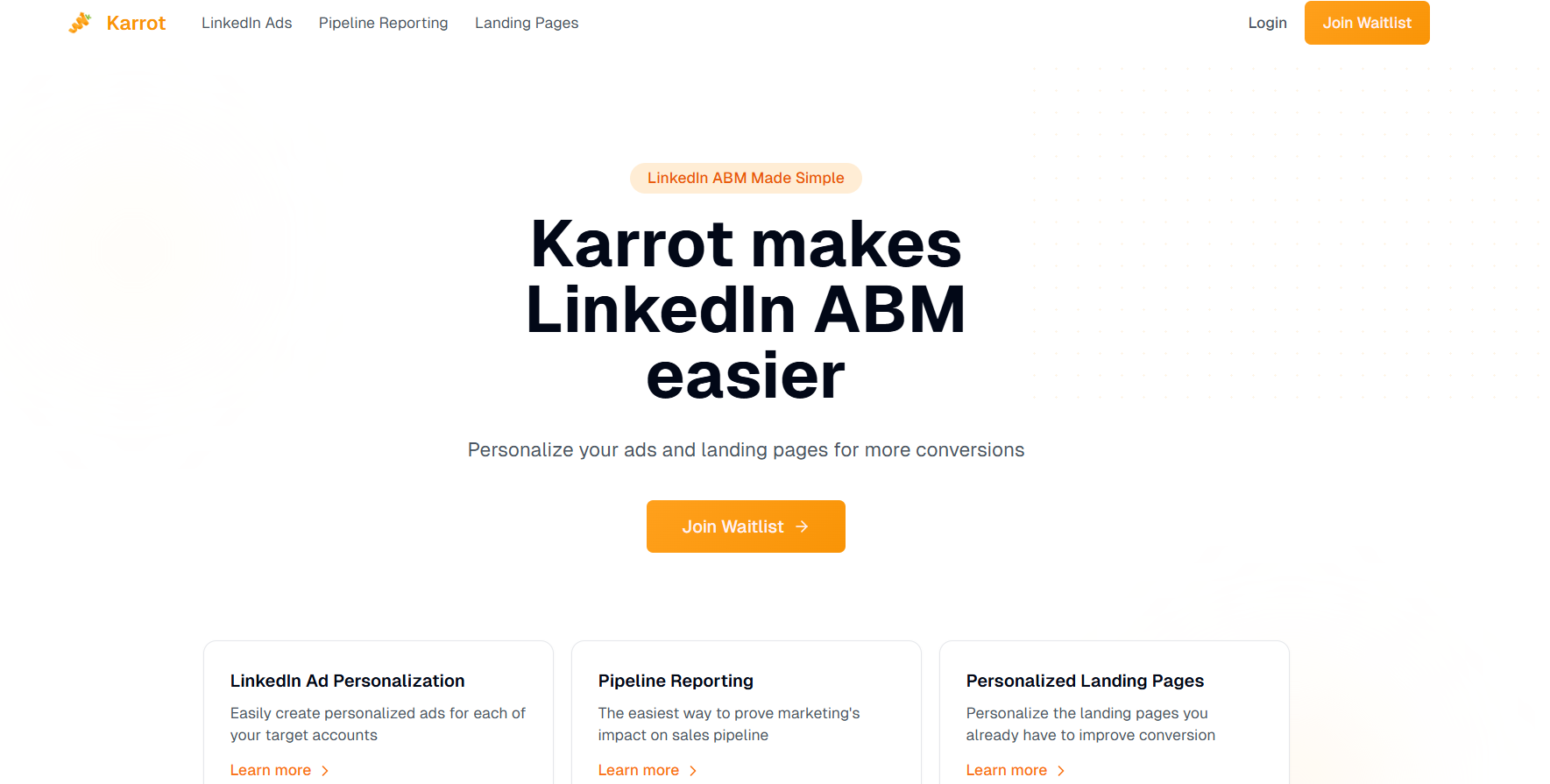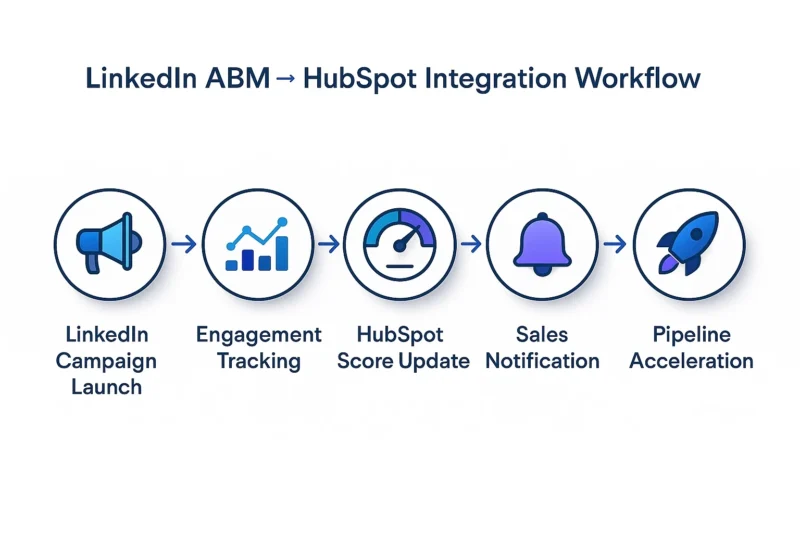How to Score AI Account Health in HubSpot for LinkedIn ABM
When an enterprise company needed to attract more leads on LinkedIn, they implemented an AI-driven ABM campaign using Karrot.ai to personalize their ads. This delivered $12.4 million in influenced pipeline after only six months.

The secret wasn’t just better targeting; it was creating a predictive scoring system that automatically surfaced the highest-value opportunities. This comprehensive guide reveals how to build that same systematic approach to account health scoring, specifically designed for LinkedIn ABM campaigns managed through HubSpot. You’ll discover the exact frameworks, AI integrations, and optimization strategies that turn scattered engagement data into a prioritized pipeline of sales-ready accounts.
Key Takeaways
- Build a three-layer scoring framework that combines ICP fit (40%), engagement signals (35%), and AI-powered intent data (25%) to automatically prioritize sales-ready LinkedIn ABM prospects in HubSpot
- Leverage real-time behavioral triggers beyond basic ad clicks by tracking LinkedIn conversation ad responses, video completion rates, and sustained engagement patterns to identify genuine buying interest
- Implement dynamic scoring adjustments that automatically reduce account health scores for prospects inactive for 30+ days, while increasing scores for accounts showing sustained LinkedIn engagement patterns
- Use AI predictive scoring to identify conversion patterns that reveal which combinations of fit and engagement signals most consistently lead to closed deals, enabling continuous model optimization
- Establish closed-loop measurement systems that correlate account health scores with actual sales outcomes, allowing you to refine AI models and achieve measurable pipeline improvements within 90 days
TABLE OF CONTENTS:
Understanding AI Account Health Scoring Fundamentals
AI account health scoring in HubSpot transforms how you evaluate LinkedIn ABM prospects by combining traditional firmographic data with real-time behavioral signals. Unlike static lead scoring that relies on predetermined point values, AI-powered models continuously learn from your historical conversion data to identify patterns that predict success.
The foundation rests on two critical dimensions: account “fit” and account “engagement.” Fit measures how closely a prospect aligns with your ideal customer profile. Industry, company size, technology stack, and decision-making structure. Engagement tracks the depth and quality of their interactions across LinkedIn and your broader digital ecosystem.
What makes AI scoring particularly powerful for LinkedIn ABM is its ability to process engagement signals that traditional scoring systems miss. LinkedIn conversation ads replies, video completion rates, and profile research behaviors all feed into a dynamic score that reflects genuine buying interest rather than superficial activity.
Building Your Multi-Dimensional Scoring Framework
The most effective account health scoring systems employ a three-layer approach that strikes a balance between automation and strategic oversight. Start by establishing your Ideal Customer Profile scoring criteria within HubSpot’s custom properties framework. This includes firmographic factors such as industry vertical, employee count, annual revenue, and technology indicators that suggest a good fit.
Layer two introduces behavioral engagement scoring that captures LinkedIn-specific activities. HubSpot’s native LinkedIn Ads integration automatically tracks ad clicks, form submissions, and website visits attributed to your ABM campaigns. However, the real power comes from incorporating advanced engagement signals, such as LinkedIn conversation ad responses, document downloads, and video engagement metrics.
| Scoring Dimension | Weight | Key Signals | HubSpot Implementation |
|---|---|---|---|
| ICP Fit Score | 40% | Industry, size, tech stack | Custom contact/company properties |
| Engagement Score | 35% | LinkedIn ad clicks, content views | Behavioral triggers & workflows |
| Intent Signals | 25% | Research behavior, repeat visits | AI-powered predictive scoring |
The third layer leverages HubSpot’s AI predictive scoring capabilities to identify subtle patterns in your conversion data. This system automatically adjusts scoring weights based on which combinations of fit and engagement signals most consistently lead to closed deals. Research shows that 91% of companies report that ABM leads to an increased average deal size, making accurate account prioritization crucial for maximizing revenue impact.
LinkedIn ABM Data Integration Strategies
Seamless data flow between LinkedIn and HubSpot forms the backbone of effective AI account health scoring. Beyond HubSpot’s standard LinkedIn Ads integration, advanced implementations capture engagement data that reveals true buyer intent. This includes LinkedIn conversation ad interaction patterns, specific content piece engagement, and cross-platform attribution that connects LinkedIn touchpoints to downstream conversion events.
The key breakthrough comes from configuring HubSpot workflows that automatically update account health scores based on LinkedIn campaign performance. When a target account engages with multiple LinkedIn ad formats or demonstrates sustained interest over time, its health score increases proportionally. This real-time scoring adjustment ensures your sales team always works the hottest prospects first.

The technical implementation requires careful attention to attribution windows and decay functions. LinkedIn engagement should carry more weight when it’s recent and part of a sustained pattern rather than isolated activity. HubSpot’s workflow tools can automatically reduce engagement scores for accounts that haven’t shown LinkedIn activity in 30+ days, ensuring your scoring reflects current buyer interest.
Advanced AI-Powered Optimization Techniques
Advanced practitioners implement dynamic scoring adjustments based on LinkedIn campaign performance data. The most sophisticated account health scoring systems go beyond simple point accumulation to leverage machine learning for predictive insights. HubSpot’s AI capabilities can identify non-obvious patterns in your LinkedIn ABM data.
Accounts that engage with case study content are likelier to convert than those that only view product demos. The breakthrough insight comes from layering intent data with engagement patterns. Accounts demonstrating high fit scores, sustained LinkedIn engagement, and recent intent signals (such as job postings, funding announcements, and technology investments) receive priority routing to sales. This multi-signal approach reduces false positives while ensuring genuine opportunities get immediate attention.
Measurement and Optimization Frameworks
Effective AI account health scoring requires continuous measurement and refinement cycles to ensure optimal performance. Establish baseline metrics for your current LinkedIn ABM performance, then track how AI scoring impacts key indicators: pipeline velocity, deal size, win rates, and sales cycle length. The most successful implementations see measurable improvements within 90 days.
Create custom HubSpot reports that correlate account health scores with actual sales outcomes. This closed-loop analysis reveals which scoring criteria most accurately predict success, enabling ongoing model optimization and refinement. Account-based marketing programs leveraging LinkedIn achieve a 38% higher sales win rate than traditional approaches, making accurate scoring critical for maximizing this advantage.
Monthly scoring audits should examine both accuracy and efficiency metrics. Are high-scoring accounts converting at expected rates? Are sales teams following up on score-triggered notifications? Is the LinkedIn-to-HubSpot data flow capturing all relevant engagement signals? These operational reviews ensure your AI scoring system delivers sustained business impact.
90-Day Implementation Roadmap
Month one focuses on foundation building: audit your current HubSpot setup, establish ICP scoring criteria, and configure basic LinkedIn campaign tracking. Ensure your LinkedIn Ads integration captures all relevant engagement data and that HubSpot workflows can process this information into meaningful scores.
Month two introduces AI-powered scoring enhancements and behavioral triggers. Activate HubSpot’s predictive scoring features, implement engagement decay rules, and create automated workflows that notify sales when accounts reach high-health thresholds. Test scoring accuracy against a control group to validate model performance.
Month three emphasizes optimization and scaling. Analyze which scoring factors most accurately predict conversions, refine AI model inputs based on actual sales outcomes, and expand successful patterns across your entire ABM program. Document learnings and best practices for continued improvement.
The technical implementation benefits from expert guidance, particularly when integrating advanced LinkedIn engagement data with HubSpot’s AI capabilities. If you’re ready to accelerate your LinkedIn ABM results through intelligent account scoring, consider getting professional support to avoid common pitfalls and ensure optimal setup from day one.
Transforming ABM from Activity to Intelligence
The evolution from basic lead scoring to AI-powered account health assessment represents a fundamental shift in B2B marketing strategy. Instead of reacting to individual actions, you’re now predicting buyer readiness based on comprehensive behavioral patterns and predictive signals. This intelligence-driven approach transforms LinkedIn ABM from hopeful outreach into targeted revenue acceleration.
The businesses seeing the greatest success combine technical sophistication with strategic discipline. They implement robust scoring frameworks, continuously optimize based on performance data, and maintain tight alignment between marketing intelligence and sales execution. The result: higher conversion rates, shorter sales cycles, and more predictable revenue growth.
Your next step depends on your current HubSpot configuration and LinkedIn ABM maturity. Whether you’re building your first scoring model or optimizing an existing system, the key is to start with solid foundations and iterate based on real performance data.
Get a Free Audit to assess your current setup and identify the highest-impact optimization opportunities for your specific business context.
Ready to turn your LinkedIn ABM data into a predictive revenue machine?
Related Video
Frequently Asked Questions
-
What are the three main components of an effective account health scoring framework?
The most effective framework combines ICP fit scoring (40%), engagement signals (35%), and AI-powered intent data (25%). This three-layer approach balances firmographic fit with behavioral indicators and predictive insights to automatically prioritize sales-ready prospects.
-
How does AI account health scoring differ from traditional lead scoring?
Unlike static lead scoring that uses predetermined point values, AI-powered models continuously learn from historical conversion data to identify success patterns. This approach processes engagement signals that traditional systems miss, such as LinkedIn conversation ad replies and video completion rates, creating dynamic scores that reflect genuine buying interest.
-
What specific LinkedIn engagement signals should be tracked for account health scoring?
Beyond basic ad clicks, track LinkedIn conversation ad responses, video completion rates, sustained engagement patterns, and cross-platform attribution that connects LinkedIn touchpoints to conversion events. Profile research behaviors and repeat content interactions also provide valuable intent signals for scoring models.
-
How quickly can businesses expect to see results from implementing AI account health scoring?
Most successful implementations see measurable improvements within 90 days. The 90-day roadmap includes foundation building in month one, AI enhancement implementation in month two, and optimization and scaling in month three based on actual performance data.
-
How should account health scores be adjusted for inactive prospects?
Implement dynamic scoring adjustments that automatically reduce engagement scores for accounts showing no LinkedIn activity for 30+ days. This ensures your scoring reflects current buyer interest rather than outdated engagement, helping sales teams focus on genuinely active prospects.
-
What metrics should be used to measure the effectiveness of AI account health scoring?
Track pipeline velocity, deal size, win rates, and sales cycle length as key performance indicators. Create custom HubSpot reports that correlate account health scores with actual sales outcomes to identify which scoring criteria most accurately predict success and enable ongoing model optimization.
-
How can businesses ensure accurate data flow between LinkedIn and HubSpot for scoring?
Configure HubSpot workflows that automatically update account health scores based on LinkedIn campaign performance, ensuring real-time scoring adjustments. Implement careful attribution windows and decay functions so recent, sustained LinkedIn engagement carries more weight than isolated or outdated activity.



